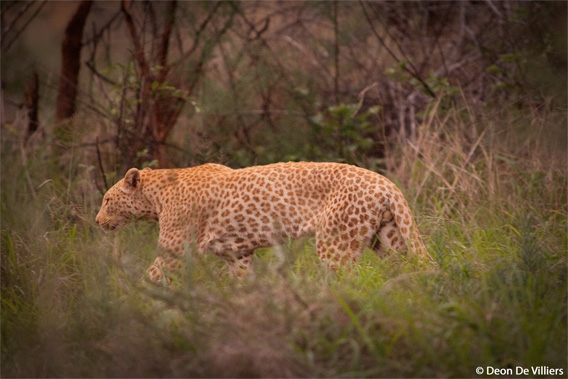
A “strawberry” leopard walking in South Africa’s Madikwe Game Reserve. Photo © Deon De Villiers.
This photo of the day features a “strawberry” leopard walking in South Africa’s Madikwe Game Reserve taken by wildlife photographer and safari guide, Deon De Villiers.
Dr. Luke Hunter, an expert on leopards and President of Panthera – the world’s leading conservation organization dedicated to wild cats – was recently asked by Deon about this rare leopard.
“This is very unusual, I’ve never seen this color variation in leopards,” explained Hunter. “I think it is a case of erythrism, an overproduction of red pigment or underproduction of dark pigments such as melanins, resulting in an overall reddish or strawberry coloration to the fur. It is occurs from time to time in a variety of species but it is not common. In carnivores, it is very rare, but appears to occur most often in raccoons, Eurasian badgers and coyotes; it has also been recorded very rarely in American badgers and some weasel species. There are some spotted leopard skins and melanistic specimens (‘black panthers’) in museums with red undertones but fading probably contributes to that; this is the first case like this I’ve seen in a wild leopard.”
Leopards are the most versatile of big cats and occupy all habitats from the Congo rainforest to true deserts. However, even with their remarkable adaptability, leopards have vanished from almost 40% of their historic range in Africa, and from over 50% of their historic range in Asia. Leopards are now extinct in 6 countries they formerly occupied, and their presence in 6 additional countries is very uncertain.
Learn more about leopards and conservation projects like Panthera’s Munyawana Leopard Project to ensure a future for this species.














